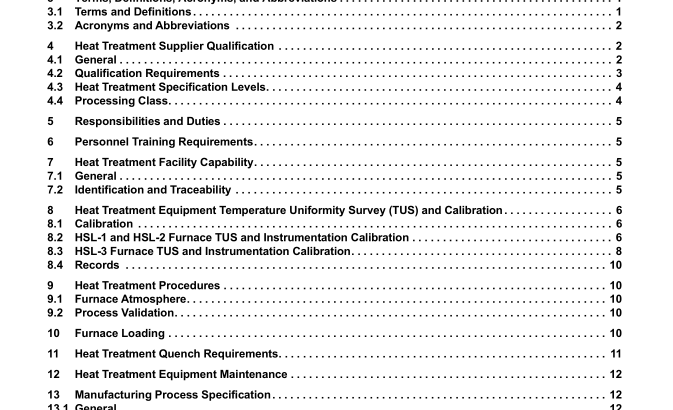API St 20H:2015 pdf free download.Heat Treatment Services—Batch Type for Equipment Used in the Petroleum and Natural Gas Industry
8 Heat Treatment Equipment Temperature Uniformity Survey (TUS) and Calibration
8.1 Calibration Equipment used to record heat treatment or other equipment necessary to control heat treatment operations shall be identified, controlled, calibrated, and adjusted at specified intervals to maintain the accuracy required by this standard. Calibration shall be performed in accordance with documented instructions, which are consistent with nationally or internationally recognized standards specified by the heat treatment supplier. Records shall be maintained.
8.2 HSL-1 and HSL-2 Furnace TUS and Instrumentation Calibration
8.2.1 TUS Temperature Tolerances (High Heat Only) The temperature at any point in the working zone of a furnace used for austenitizing, normalizing, annealing, or solution annealing shall not vary by more than ±25 °F (±14 °C) from the furnace set-point temperature after the furnace working zone has been brought up to temperature.
8.2.2 TUS Temperature Tolerances (Low Heat Only) Furnaces used for tempering, aging, and/or stress-relieving shall not vary by more than ±15 °F (±8 °C) from the furnace set-point temperature after the furnace working zone has been brought up to temperature.
8.2.3 TUS Temperature Tolerances (Combined Low and High Heat Furnaces) For furnaces used for both the heat treatment operations specified in 8.2.1 and 8.2.2, the heat treatment supplier shall define the temperature range for each operation. The furnace temperature tolerance shall conform to the requirements specified in 8.2.1 or 8.2.2, as appropriate.
8.2.4 TUS Method for Batch-type Furnaces 8.2.4.1 A TUS within the furnace working zone(s) shall be performed on each furnace at the maximum and minimum temperatures for each range for which the furnace is being used. a) A minimum of nine thermocouple test locations shall be used for all furnaces having a working zone greater than 10 ft 3 (0.3 m 3 ). For each 125 ft 3 (3.5 m 3 ) of furnace working zone surveyed, at least one thermocouple test location shall be used, up to a maximum of 40 thermocouples
See Figures 1 and 2 for examples of thermocouple locations. b) For furnaces having a working zone less than 10 ft 3 (0.3 m 3 ), the temperature survey may be made with a minimum of three thermocouples located either at the front, center, and rear or at the top, center, and bottom of the furnace working zone.
8.2.4.2 After insertion of the temperature-sensing devices, readings shall be taken at least once every three minutes to determine when the temperature of the furnace working zone approaches the bottom of the temperature range being surveyed.
8.2.4.3 Once the furnace temperature has reached the set-point temperature, the temperature of all test locations shall be recorded at 2-minute intervals, maximum, for at least 10 minutes. Then, readings shall be taken at 5-minute intervals, maximum, for sufficient time (at least 30 min) to determine the recurrent temperature pattern of the furnaceworking zone.
8.2.4.4 Before the furnace set-point temperature is reached for austenitizing, normalizing, or solution annealing, none of the temperature readings shall exceed the set-point temperature by more than 25 °F (14 °C). Before the furnace set-point temperature is reached for tempering or aging, none of the temperature readings shall exceed the set-point temperature by more than 15 °F (8 °C).
8.2.4.5 After the furnace control set-point temperature is reached, no temperature reading shall vary beyond the limits specified.
8.2.4.6 When a furnace is repaired or rebuilt, a new temperature survey shall be carried out before the furnace is used for heat treatment, except for minor repairs as noted below. Minor repairs or replacement of damaged or malfunctioning components or scheduled preventive maintenance that restores the furnace to its original condition and are not expected to affect the temperature uniformity characteristics of the furnace shall not require repeating the TUS. Examples include, but are not limited to, the following:
a) replacing a burner or tile with another duplicate burner or tile,
b) refractory repair using material with similar thermal properties,
c) replacing a control or monitoring sensor to its previously documented location.API St 20H pdf download.API St 20H:2015 pdf free download
